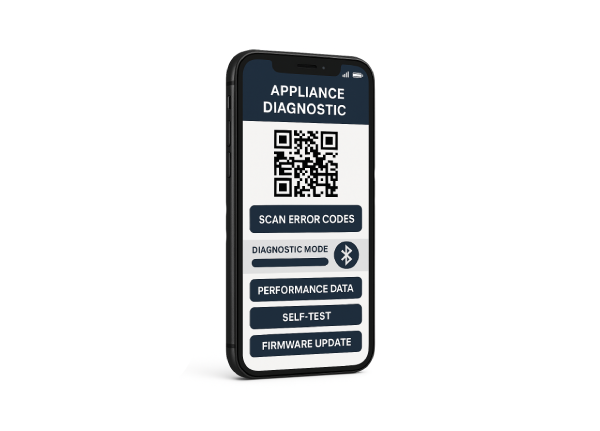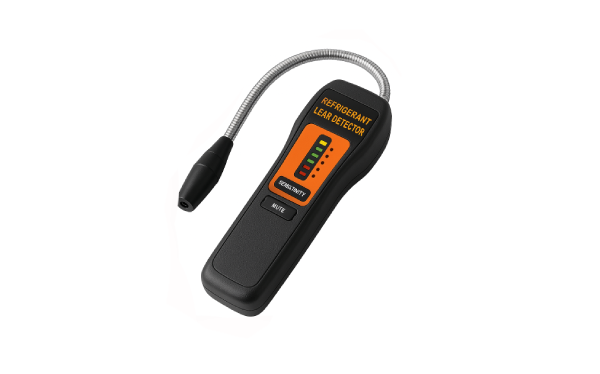Looking to grow your appliance repair business and attract more customers? That’s where SEO, or Search Engine Optimization, comes in. These days, people are short on time — when they need appliance repairs, they’ll quickly look through Google’s local listings or even ask ChatGPT. That’s why showing up first in local search results is key to winning the call.
Local SEO doesn’t just drive traffic — it drives real results. About 76% of people who search for a local service on their smartphone visit a business within a day, and 28% of those searches lead to a purchase. Therefore, if growth is your goal, local SEO should be your starting point.
This guide covers step-by-step local SEO tips that actually work for appliance repair companies in 2025.
Get Exclusive Appliance Repair Leads
1. Start With Local Keywords: What Your Appliance Repair Customers Are Actually Searching
Keywords are the words and phrases people type into Google when they’re looking for something, like “washer repair near me” or “fridge technician in Chicago.” If you include the right keywords on your website, you’re more likely to show up in those searches. That’s why finding the right local keywords is one of the first and most important steps in local SEO.
To find the best keywords, try the free version of Ahrefs’ Keyword Explorer or use Semrush’s 7-day trial to see what people in your area are actually searching for. Google Keyword Planner is another great (and free) option, though it does require signing up for a Google Ads account. All of these tools offer valuable insights into the real search terms your future customers are using.
Start by typing in topics related to the services you offer — like “dryer repair” or “oven not heating.” The tools will generate a list of keywords that people are actually searching for. You’ll want to focus on two types of keywords: those with commercial intent and those with informational intent.

- Commercial intent keywords are used by people ready to hire or book a service — for example, “appliance repair near me” or “same day fridge repair.”
- Informational intent keywords are searched by people looking for advice or answers, like “why is my dishwasher leaking” or “how to fix a noisy dryer.”
2. Use the Local Keywords You Found to Optimize Your Website
Now that you’ve gathered a list of commercial and informational keywords, the next step is putting them to use. By strategically adding these keywords to your appliance repair website, you can boost your chances of showing up in local search results. Here’s how to do it effectively:
Home page and Service Pages
Start by optimizing your homepage and main service pages with commercial intent keywords — the ones people search for when they’re ready to hire.
For example, if “emergency appliance repair near me” is a common search in your area, make sure it appears naturally in your homepage title tag, meta description, and page content.
Title tag, Heading and Subheadings
Add your target keywords to key places on each page — especially the title tag, main heading (H1), subheadings (H2s and H3s), and body content. This helps search engines understand what your page is about and improves your chances of ranking for those terms.
Blog Posts and FAQs
Use your informational keywords in blog posts, FAQs, and other helpful content on your site. These terms attract people who are looking for advice or troubleshooting help, and they’re a great way to bring in traffic before someone is ready to book.
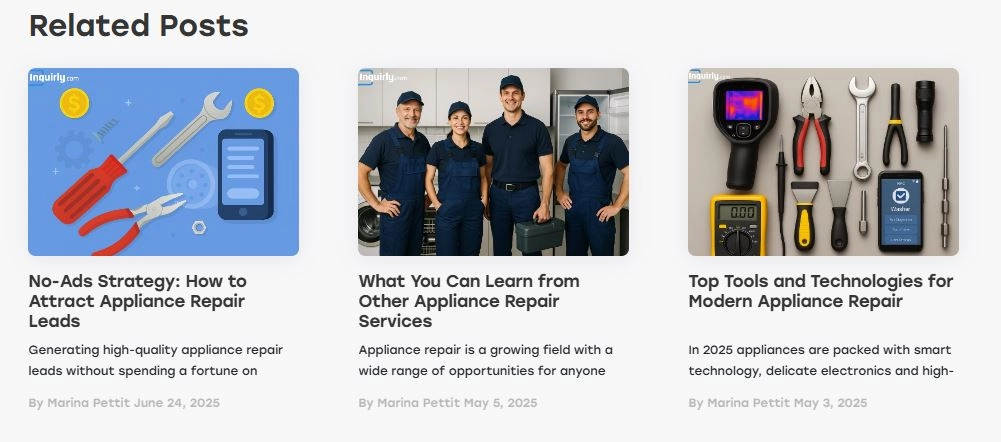
URLs, SEO Titles and Meta Description
Make sure your target keywords also appear in your page URLs, meta descriptions, and SEO titles. These elements help search engines understand your content and can improve your click-through rate when people see your site in search results.
Remember:
- Always make sure your keywords appear naturally.
- Avoid keyword stuffing — forcing keywords in too often can actually hurt your rankings and make your site harder to read.
- Aim for clarity and flow first, and let the keywords support your message.
3. Set-Up Google Business Profile for Your Appliance Repair Business
If you want to show up on Google Maps or in the local pack (the map and listings at the top of search results), creating a Google Business Profile is a must. It’s free, easy to set up, and a powerful way to attract local customers — even if you don’t have a physical storefront. Here’s how to do it:
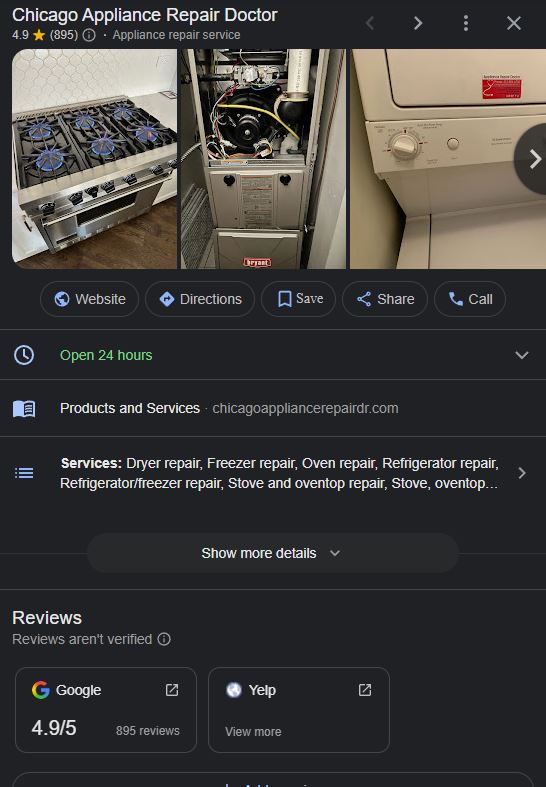
- Go to google.com/business and sign in with your Google account.
- Enter your business name exactly as you want it to appear.
- Choose your primary category — select “Appliance Repair Service” to make sure you show up for the right searches.
- Add your service areas, phone number, and website (if you have one).
- Set your business hours and make sure they reflect when people can reach you.
- Write a short business description that clearly explains what you offer.
- Upload clear photos of your work, team, tools, or vehicle — real photos help build trust.
- Verify your business — Google will mail you a postcard with a code, or in some cases, allow phone or email verification.
4. List Your Appliance Repair Business on Trusted Local Platforms
Getting listed on local directories helps boost your visibility, build trust, and improve your local SEO. Think of these platforms as extra paths that lead customers straight to your business.
Start by submitting your business to:
- Yelp
- Better Business Bureau (BBB)
- Angi (formerly Angie’s List)
- YellowPages
- Local Chamber of Commerce directories
- Neighborhood-specific platforms like Nextdoor
- City or region-specific directories (search for “[Your City] + business directory”)
Tips for better results:
- Use the same business name, address, and phone number (NAP) on every listing.
- Write a short, consistent business description across all platforms.
- Add photos when possible — they increase trust and engagement.
- Keep your listings up to date — update hours, services, or contact info if anything changes.
The more accurate and consistent your listings are, the more likely you are to appear in local search results.
✅ Local Directory Listing Checklist
- List your business on Yelp, BBB, Angi, and YellowPages
- Find and submit to local or regional directories
- Use consistent business name, address, and phone number (NAP)
- Add a clear, professional business description
- Upload high-quality photos (team, tools, service in action)
- Double-check hours and contact details
- Revisit listings every few months to keep them updated
5. Collect and Manage Online Reviews
Online reviews are one of the biggest trust signals for local customers. When someone searches for “appliance repair near me,” they’re not just looking at who shows up — they’re checking ratings, reading reviews, and deciding who feels the most trustworthy.
That’s why collecting and managing reviews is a critical part of local SEO. The more positive, recent reviews you have, the more likely people are to choose your business, and the more likely Google is to rank you higher.
How to Collect and Manage Reviews:
- Ask every happy customer for a review
After completing a job, send a quick text or email with a polite request and a direct link to your Google Business Profile. - Make it easy
The fewer steps it takes, the more likely people are to leave a review. Use a short, direct link and simple instructions. - Don’t wait too long
Ask while the experience is still fresh. If possible, bring it up right after the service or during follow-up communication. - Respond to all reviews — even the bad ones
Thank people for positive feedback, and reply professionally to negative reviews. Showing that you care makes a difference. - Avoid fake or incentivized reviews
Google may remove suspicious reviews, and it can hurt your credibility. Focus on earning real reviews through good service. - Keep the momentum going
Make reviews a regular part of your process, not just a one-time effort.
Review Request Template:
Hi [Customer Name],
Thanks again for choosing [Your Business Name]! If you were happy with the service, we’d really appreciate it if you could take a moment to leave us a Google review. It helps other people find us — and lets us keep improving.
👉 [Insert your Google review link here]
Thanks again, and let us know if you ever need anything!
— [Your Name / Business Name]
6. Add Local-Focused Content to Help Your Website Rank Higher
Creating helpful content for your appliance repair website is one of the best ways to rank for informational keywords. When you publish blog posts that answer common repair questions or explain how appliances work, you naturally bring in more traffic. More local users will find your business while searching for advice, and some of them will turn into paying customers. Content builds trust, boosts visibility, and drives leads over time.
Best Practices for Creating Local-Focused Content:
- Answer real customer questions
Use questions you often hear from customers as blog topics — they’re likely being Googled, too. - Mention your service areas naturally
Don’t just stuff city names. Write about real problems in real places (e.g., “dishwasher issues in Chicago apartments”). - Target long-tail keywords
Focus on phrases like “why is my dryer making a thumping noise” or “how to reset a GE washing machine.” - Keep it simple and helpful
Avoid jargon. Your content should feel like advice from a pro, not an instruction manual. - Add internal links
Link blog posts to your service pages or contact page to guide readers toward booking. - Use clear headings and images
Break content into sections with H2s and use photos or diagrams where helpful. - Publish consistently
Even one new post per month helps Google see your site as active and relevant.
Content Ideas for Your Appliance Repair Website:
- How to Troubleshoot a [Brand] Dishwasher That Won’t Start
- 5 Common Appliance Problems in [City Name] Homes
- When to Repair vs. Replace Your Washing Machine
7. Build Local Backlinks
Backlinks — links from other websites to yours — are one of the strongest signals Google uses to rank websites. When trusted, local, or industry-related websites link to your appliance repair site, it shows Google that your business is reputable and worth ranking.
The more high-quality backlinks you earn, the more likely your site is to appear higher in local search results. But not all backlinks are equal — focus on getting links from websites that are relevant to your business and your service area.
How to Earn Local and Relevant Backlinks:
- Join local business directories and associations
Get listed on your Chamber of Commerce website or local business networks — many of them link back to member sites. - Partner with local service providers
Connect with plumbers, electricians, or real estate agents — offer to refer each other and link between websites. - Sponsor a local event or team
Small sponsorships often come with a logo placement and backlink from the event’s website. - Write guest posts for home improvement blogs
Reach out to local bloggers or websites in related industries and offer helpful articles in exchange for a backlink. - Get featured in local media
If you have a unique story, offer seasonal tips, or launch a new service, pitch it to local news outlets. - Ask suppliers or manufacturers for a link
If you’re a certified repair provider or partner with a brand, they might be willing to link to your site.
Avoid spammy backlinks at all costs.
Not all links are good links. Buying links or getting listed on unrelated, low-quality websites can actually hurt your rankings. Focus on building genuine, relevant connections with trusted local or industry sites — quality always beats quantity in local SEO.
8. Analytics – Track Your Local SEO Performance
Once you’ve put in the work to improve your local SEO, it’s important to track what’s actually working. Using tools like Google Analytics and Google Search Console, you can monitor how people are finding your website, what pages they visit, and which keywords are driving traffic.
Pay special attention to metrics like local impressions, clicks, and calls from your Google Business Profile. These insights help you understand what to improve — and where you’re already winning.
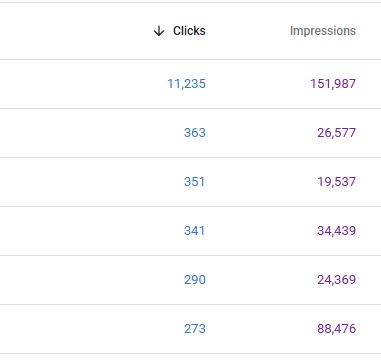
What to Track:
- Website traffic from local searches
In Google Analytics, look at traffic sources and see how many users come from organic search — especially in your service area. - Top-performing pages
Track which service or blog pages bring in the most local traffic and leads. Double down on what’s working. - Search impressions and clicks
In Google Search Console, check your keyword performance — see how often your site appears and how often people click. - Google Business Profile insights
Track how many people view your profile, request directions, click your website, or call your business directly from search. - Call volume and form submissions
Use call tracking tools or form analytics to measure how many real leads you’re getting from your SEO efforts.
9. Competitor Analysis – Learn, Adapt, and Be Better
One of the easiest ways to improve your local SEO is by studying what’s already working for other appliance repair businesses in your area. Search for the services you offer and take note of who shows up first — then look closely at their websites, content, reviews, and Google Business Profiles.
What keywords are they using?
How many reviews do they have?
Which pages seem to rank the best?
You don’t need to copy them — but you can absolutely learn from them. Use those insights to improve your own site, offer more value, and outrank the competition over time.
How to Analyze Local Competitors:
- Google your top services + location
Search for terms like “dryer repair [your city]” or “emergency appliance service near me.” See who’s showing up at the top. - Study their websites
Look at how their pages are structured, which keywords they’re using, and what kinds of content they publish. - Check their Google Business Profiles
Review their business categories, service areas, photos, and number of reviews. - Use free SEO tools
Tools like Ubersuggest, Semrush (7-day trial), or Ahrefs (free version) can show which keywords and pages drive traffic to their sites. - Compare their reviews
Are they getting more feedback? Are they replying? Use this as motivation to improve your own review strategy.
Final Tips & Summary
Local SEO isn’t a one-time task — it’s an ongoing effort that pays off over time. From choosing the right keywords to getting reviews, building backlinks, and creating helpful content, every step helps your appliance repair business show up where it matters most: in front of local customers.
Stay consistent, track your progress, and keep an eye on what your competitors are doing. The businesses that win local search aren’t always the biggest — they’re the ones who show up, stay active, and keep improving.
Want more appliance repair leads — without doing the SEO work yourself?
Inquirly delivers ready-to-book leads straight to your business.
